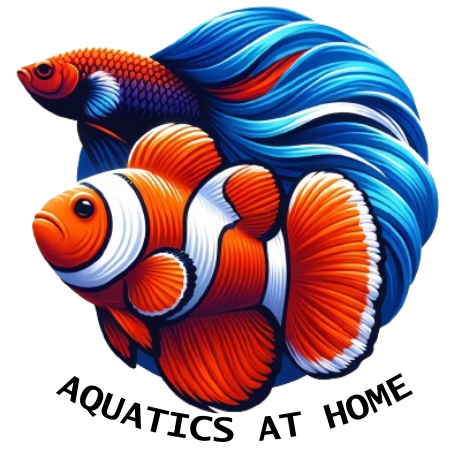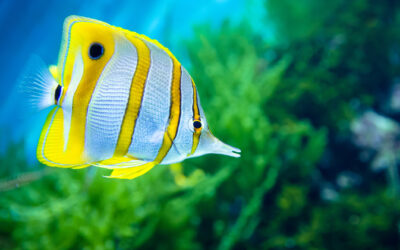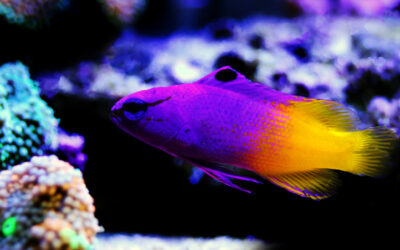If you are getting into the coral side of the saltwater aquarium hobby – you need to give mushroom corals a shot! Mushrooms can add tons of color to your tank, plus sometimes they multiply like crazy when given the right conditions. I really enjoy having mushrooms in my tanks as it becomes a fun trade-in item at my LFS when I want another new mushroom or other coral. I hope you have as much fun as I do with these colorful little sea buttons!
These corals are found in various colors and forms in different oceans around the world. In this article, we will explore everything you need to know about mushroom corals, from their unique characteristics to their role in conservation efforts.
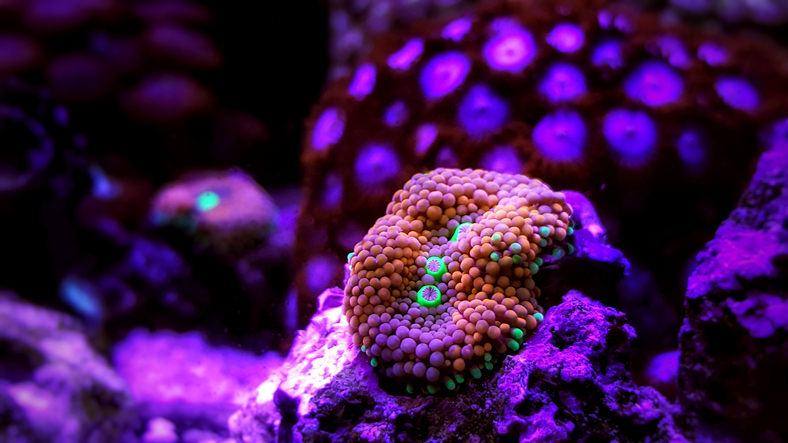
Understanding Mushroom Coral: An Introduction
What are Mushroom Corals?
Let me tell you about these cool sea creatures called Corallimorpharia, or “mushroom corals” for short. They’re related to stony corals and sea anemones, and you can find them hanging out in oceans all around the world—from tropical waters to deeper, colder areas.
Mushroom corals have a round or oval body with a mouth in the center, surrounded by tentacles that have special stinging cells for catching food and defending themselves. They come in a bunch of different colors and patterns, which is why people who have aquariums really like them.
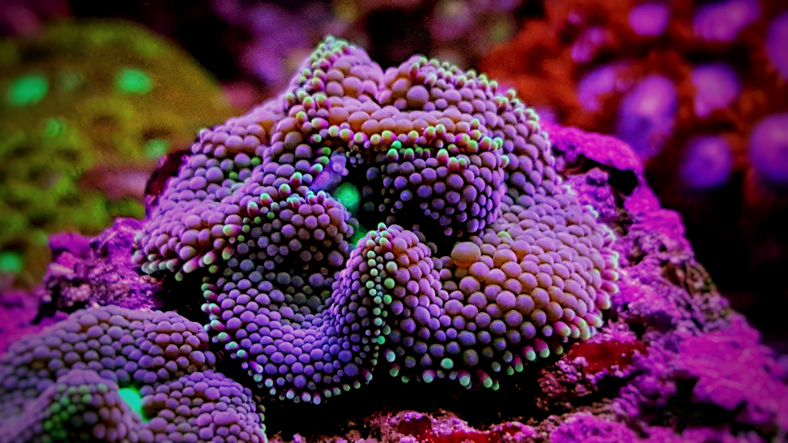
Now, there are four families of mushroom corals:
- Corallimorphidae: This family has the most variety, with about 12 different types, like Discosoma and Rhodactis. They have a flat, disc-like body and short, stubby tentacles. You can usually find them in shallow water spots, like coral reefs and rocky shores, either on their own or in groups.
- Discosomatidae: This family is smaller, with only two types called Amplexidiscus and Discosoma. They’re nicknamed “elephant ear mushrooms” because of their unique shape. They’ve got super flexible bodies and long tentacles, and they live in different places, from shallow coral reefs to deeper waters.
- Ricordeidae: There’s just one type in this family called Ricordea. They’re known for their cool bubble-like tentacles, which they use to catch food and scare off predators. You can find them in the Caribbean and the Indo-Pacific region, usually attached to rocks or dead coral in shallow waters.
- Sideractinidae: This is another cool family of mushroom corals, and it includes the genus Sideractis. Members of the Sideractinidae family have a unique appearance with a somewhat flattened body, but they also sport some impressive tentacles, which can be long and wavy. These tentacles not only help them grab food and fend off predators, but they also look amazing when they sway with the ocean currents. You can usually find Sideractinidae in tropical and subtropical waters, often in deeper areas where they cling to rocks and other hard surfaces.
The Importance of Mushroom Corals in Marine Ecosystems
These mushroom corals have a pretty important job in the ocean. They provide a home for lots of other sea creatures and help recycle nutrients. They also have a cool partnership with tiny algae called zooxanthellae that live inside them. The algae make food through photosynthesis and share it with the corals, while the corals give the algae protection and sunlight.
Additionally, mushroom corals are important indicators of the health of coral reefs. They are sensitive to changes in water temperature and quality, and their well-being is closely tied to that of the surrounding ecosystem. If mushroom coral populations decline, it can be a sign of larger issues affecting the reef.
Unfortunately, mushroom corals are facing some challenges, like losing their homes, pollution, and climate change. When the ocean gets too warm, they can lose their algae buddies in a process called coral bleaching, which can eventually kill them. Plus, people sometimes take too many of them from the ocean for their aquariums, which isn’t great for their populations. I recommend you check with your LFS to ensure you only purchase captive propagated mushrooms – they grow so easily in tanks, and this should not limit your selection.
So, that’s the lowdown on Corallimorpharia or mushroom corals. They’re a fascinating bunch of sea creatures with a lot of different shapes, colors, and roles in the ocean. By understanding more about them and the challenges they face, we can help protect them and make sure they’re around for a long time to come.
Color Variations and Patterns
One of the most striking features of mushroom coral is its vast range of colors and patterns. These corals come in a variety of hues, including brown, green, orange, and black. But what makes them truly special is the way these colors can be combined with patterns to create even more unique designs.
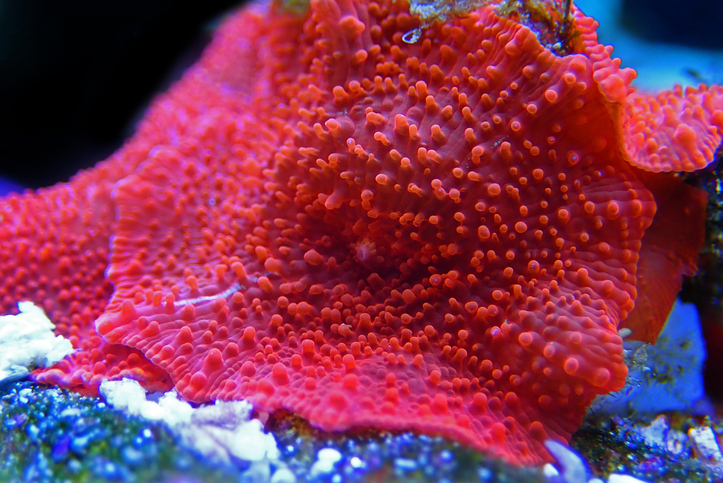
Some mushroom corals have spots or stripes, while others have intricate swirls or mottled patterns. These variations make them a popular choice for home aquariums, as they can add a pop of color and texture to any tank.
Growth and Reproduction
Mushroom corals are known for their fast growth rate. In ideal conditions, these corals can double in size every few months. This means that they can quickly fill up a tank and provide a stunning display for aquarium enthusiasts.
But what’s even more fascinating is the way that mushroom corals reproduce. These corals use a process known as fragmentation, whereby a part of the coral breaks off into a new organism. This method of reproduction makes them particularly hardy and adaptable to different environments.
However, it’s important to note that mushroom corals can also be fragile and sensitive to changes in water quality. As such, it’s important to maintain a stable environment in your tank to ensure their continued growth and health. It seems kind of weird, but despite the fact you can cut it up, and all the pieces might grow into new mushrooms… but if the water quality is low, your mushrooms won’t grow.
The Symbiotic Relationship with Zooxanthellae
Another interesting aspect of mushroom coral is its symbiotic relationship with tiny algae called zooxanthellae. These algae live inside the coral’s tissues and provide them with essential nutrients through photosynthesis. In turn, the coral provides the algae with a safe, protected environment to thrive.
This relationship is crucial to the survival of mushroom coral, as it allows them to grow and thrive in a variety of environments. It also means that they can be particularly sensitive to changes in light and water quality, as any disruption to the algae’s ability to photosynthesize can have a negative impact on the coral’s health.
Mushroom coral is a beautiful and unique species that has captured the hearts of many aquarium enthusiasts. Their vibrant colors and patterns, fast growth rate, and symbiotic relationship with zooxanthellae make them a fascinating addition to any tank. However, it’s important to remember that these corals can be fragile and sensitive to changes in water quality, so it’s important to provide them with a stable environment to ensure their continued health and growth.
Common Aquarium Species of Mushroom Coral
There are several different species of mushroom coral that you will find at your local fish store, each with its own distinct characteristics and care requirements.
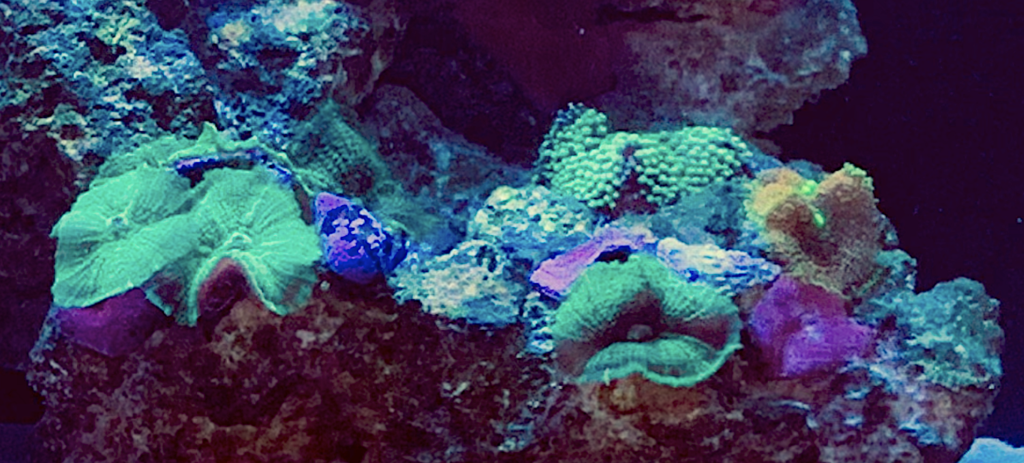
Discosoma Species
Discosoma mushroom corals are the most commonly found species in the coral reef. They come in a range of colors and patterns, including blue, green, purple, and orange. They can grow up to a few inches in diameter but don’t worry if they bump up against each other since they often reproduce by fragmentation. These corals are easy to care for, making them popular in home aquariums. They prefer low to moderate lighting and gentle water movement.
One interesting fact about Discosoma mushroom corals is that they are able to reproduce asexually, meaning they can clone themselves without the need for a mate. This allows them to quickly spread and cover large areas of the reef.
Rhodactis Species
Rhodactis mushroom corals have a distinct wavy pattern on their cap and can grow up to ten inches in diameter. They are found in a range of colors, including green, blue, and red. These corals need more care and attention than other mushroom coral varieties and can be less tolerant of changes in water conditions. They prefer moderate to high lighting and moderate water movement.
In the wild, Rhodactis corals are often found in shallow waters, where they can receive plenty of sunlight. They are known to host a variety of small marine animals, including shrimp and crabs, which live in the crevices of their cap.
Actinodiscus Species
Actinodiscus mushroom corals have a round cap, sometimes described as a disk, and come in a range of colors, from light green to bright orange. They are easier to care for than Rhodactis corals but require more water movement to thrive. They prefer moderate to high lighting and strong water movement.
Actinodiscus corals are known for their ability to rapidly expand and cover large areas of the reef. This can be both beneficial and detrimental, as they can provide shelter and food for other marine animals but can also outcompete other coral species for resources. I once received a rock full of green elephant ear mushrooms and split them between three friends. Mine thrived but remained lower in my space. One of my friends had a much bigger system, and his mushrooms grew to a massive size. They multiplied quickly, and he eventually gave them to his local fish store since they took up too much space.
Overall, mushroom corals are a fascinating addition to any saltwater aquarium. With their unique appearance and relatively easy care requirements, they are a great choice for both beginner and experienced hobbyists alike.
Mushroom Coral Care and Maintenance in Aquariums
Are you considering adding mushroom corals to your aquarium? Let’s take some time to understand mushroom care requirements to keep them healthy and thriving. Here are some key tips for maintaining mushroom corals in your tank.
Ideal Tank Conditions
Mushroom corals are generally hardy and adaptable to a range of water conditions, making them an excellent choice for beginners. However, they do require specific conditions to thrive. To create an ideal environment for your mushroom corals, you’ll need to maintain stable water parameters, though mushrooms are more forgiving than pretty much any SPS coral.
It’s also important to provide moderate lighting and gentle water flow in your tank – just remember that if the flow is too strong, the mushroom will let go of its position on whatever rock it’s attached to in an effort to find an area with lower flow. If that space happens to be populated with other corals, mushrooms can be pretty aggressive, so I would recommend you consider moving your other corals for their safety.
When it comes to lighting, you’ll want to choose a spectrum that mimics natural sunlight. Kessil and AI LED lights are popular choices for aquariums, as they offer a range of color options and can be programmed to adjust throughout the day. It’s important not to expose your mushroom corals to too much light, as this can cause them to bleach and die. Watch all of your corals with new lighting closely, as you can make adjustments before any major damage comes up.
Feeding and Nutrition
Mushroom corals are photosynthetic organisms and primarily feed on light, as they have a symbiotic relationship with zooxanthellae. However, they can also benefit from supplemental feeding once or twice a week. You can offer small pieces of shrimp, marine plankton, or similar foods to provide additional nutrients for your corals.
Avoid feeding your corals during the night, as this can disrupt their natural feeding patterns.
Common Issues and Solutions
Like all living creatures, mushroom corals can experience health issues. One common problem is brown jelly disease, which can cause decay and death of the coral. Maintain stable water conditions to prevent this and other health issues, such as temperature and pH levels. You should also avoid overcrowding your tank, as this can lead to stress and disease among your corals.
If you notice any problems with your mushroom corals, such as discoloration or unusual behavior, it’s important to act quickly. Move the affected coral to a quarantine tank and seek professional advice to restore it to good health. Sometimes, this might mean fragging the mushroom, only leaving the healthy remaining part intact.
Mushroom corals can require specific care and attention to thrive. By maintaining stable water conditions, providing appropriate lighting and feeding, and monitoring for common health issues, you can enjoy the beauty and diversity of these fascinating creatures in your underwater world.
The Role of Mushroom Coral in Coral Reef Conservation
Coral reefs are often referred to as the “rainforests of the sea” due to their incredible biodiversity and importance to the marine ecosystem. Mushroom coral, a type of soft coral, plays a crucial role in coral reef conservation efforts.
Threats to Coral Reefs and Mushroom Coral
Unfortunately, coral reefs and mushroom corals are under threat from a range of factors, including climate change, overfishing, and pollution. Climate change causes sea temperatures to rise, which can lead to coral bleaching and death. Overfishing can destroy the delicate balance of the marine ecosystem, and pollution can damage the coral’s tissue, hindering its ability to thrive.
As a result of these threats, many coral reefs around the world are in danger of disappearing altogether. This would have devastating consequences for the countless species that depend on coral reefs for their survival.
Conservation Efforts and Initiatives
Various initiatives are underway to protect and preserve coral reefs, including habitat restoration programs and coral propagation projects. Coral gardening, where a small fragment of the coral is grown in a nursery before being planted back on the reef, is a popular conservation method that has shown promising results.
In addition to coral gardening, other conservation efforts include reducing the amount of pollution that enters the ocean, regulating fishing practices, and implementing sustainable tourism practices.
How You Can Help Protect Coral Reefs
As an individual, you can contribute to the preservation of coral reefs by being mindful of your environmental impact. Reducing plastic waste, supporting sustainable fishing practices, and conserving water can all help to protect the delicate marine ecosystem.
You can also get involved in local conservation initiatives and donate to organizations working to protect the world’s coral reefs. By working together, we can help to ensure that coral reefs and the countless species that depend on them continue to thrive for generations to come.
As an avid enthusiast of marine aquariums and as someone who has enjoyed the ocean for many years – keeping our ocean healthy is so important, and as you will learn in this hobby, our aquatic friends are delicate. I don’t intend to be preachy on this site but I do want to inform you of the benefits of taking care of our oceans since I have the platform. Anyway, thank you for coming to my minor tangent – if you stuck it out, I appreciate you.
Conclusion: The Enduring Beauty of Mushroom Coral
Mushroom coral is a fascinating and beautiful species that play a vital role in the marine ecosystem. They come in a range of colors and patterns and are an excellent addition to any coral reef aquarium.
Whether you are new to mushroom corals or are just trying to understand all the different varieties available – I highly recommend you head to your local fish store to check out just how many amazing varieties can be found. If you can – find some of your favorites, treat them well, and sell the propagated mushrooms back to the store so we can continue to reduce the impact this hobby has on the environment. Take care!

About the Author
With decades of experience, James shares his extensive knowledge in aquatics through this website, covering a broad series of topics related to the pond and aquarium hobby. Aiming to guide both beginners and experienced hobbyists alike, his goal is to help educate aquatic enthusiasts for the long-term betterment of the hobby as well as the environment. Learn More >>
Exploring Butterflyfish Species for Marine Aquarium Enthusiasts
Disclaimer: This blog shares my personal experiences, research, and insights as an aquatics hobbyist. While I strive to provide accurate information, please consult a professional or your local fish store for tailored advice on your specific tank setup. Remember,...
Exploring Basslets for Your Marine Aquarium
Disclaimer: This blog shares my personal experiences, research, and insights as an aquatics hobbyist. While I strive to provide accurate information, please consult a professional or your local fish store for tailored advice on your specific tank setup. Remember,...
The Six Line Wrasse: A Comprehensive Guide to Care and Keeping
Disclaimer: This blog shares my personal experiences, research, and insights as an aquatics hobbyist. While I strive to provide accurate information, please consult a professional or your local fish store for tailored advice on your specific tank setup. Remember,...
